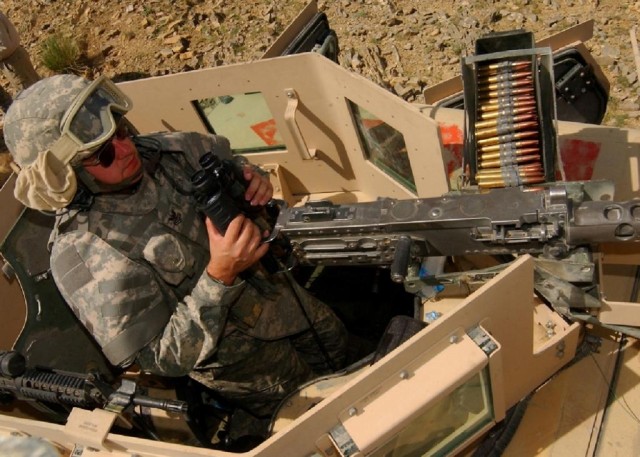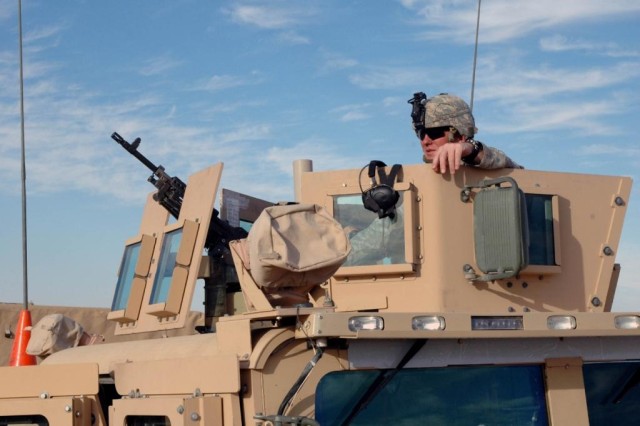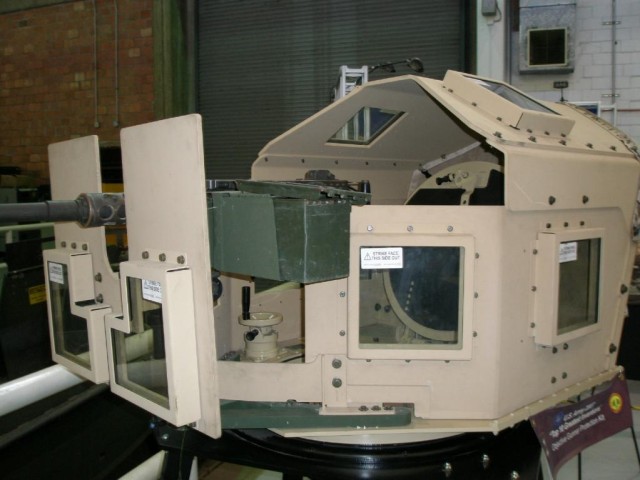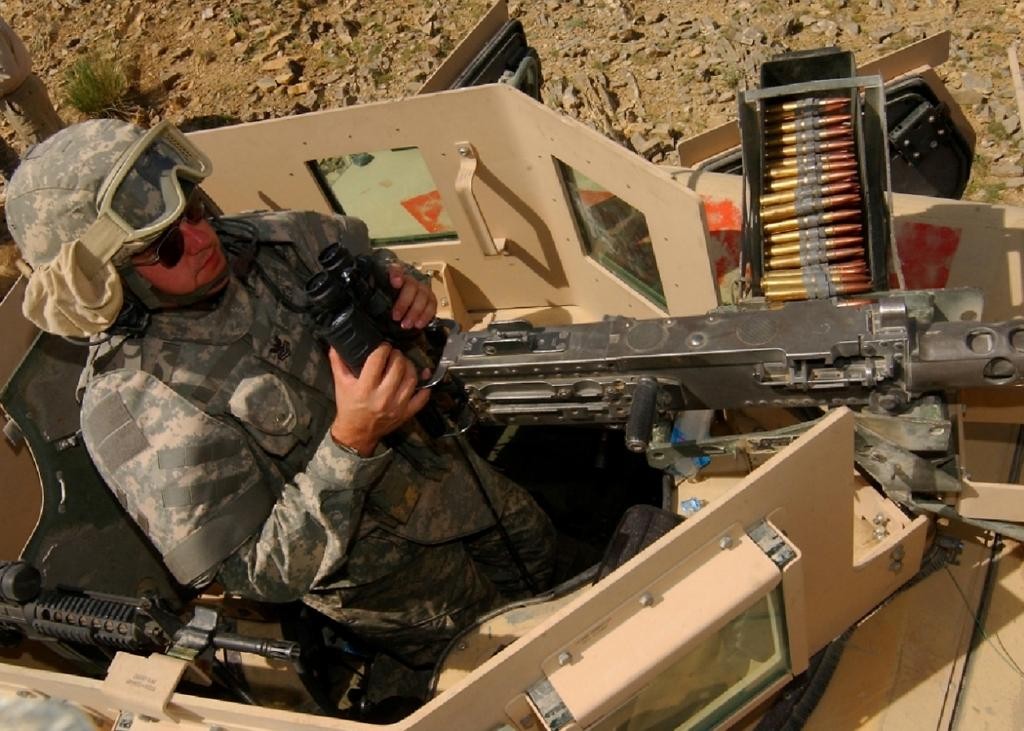PICATINNY ARSENAL, N.J. --Chances are, if a warfighter has deployed to Iraq or Afghanistan, they are familiar with the Objective Gunner Protection Kit, or OGPK.
With more than 45,000 of these systems fielded to date, the OGPK is a standard-issue equipment piece for the Army's tactical gunner vehicles - from up-armored Humvees in Operation New Dawn in Iraq and Operation Enduring Freedom in Afghanistan, as well as Mine Resistant Ambush Protected (MRAP) vehicles.
The OGPK is an integrated armor and ballistic glass turret that is mounted onto the turret ring of tactical and armored vehicles. The kit consists of a turret shield, gun shield and all necessary hardware for mounting the system to the vehicle.
But what many Soldiers may not know is how exactly the OGPK came to fruition - or further, which Army teams were responsible for developing this lifesaving product.
Picatinny Arsenal answers the call
It all started around 2005, when U.S. gunmen operating in up-armored Humvees in Iraq and Afghanistan needed significant force protection improvements against Improvised Explosive Devices and enemy small arms fire. Soldiers needed something to give them 360-degree protection yet still provide full visibility of their surroundings.
To meet the urgent need, the Army called on the expertise of the Armament Research, Development and Engineering Center (ARDEC), headquartered at Picatinny Arsenal, N.J. ARDEC and its team of government partners provided Soldiers with a finished product in just six months - a timeline nearly unheard of in the Army's world of research, development and acquisition.
"As the lead design agency, ARDEC leveraged its expertise in lethal systems, including crew served weapons and target designation systems, to ensure the full performance capability of the Humvee Turret Gunner, while also enhancing survivability and confidence for battlefield mission effectiveness," said Lead Design Engineer Thomas J. Kiel.
Soldiers loved it so much, in fact, that the OGPK was named one of the Army's top 10 Greatest Inventions for the year it was fielded in 2007. But the innovation didn't stop there. The ARDEC team used lessons learned in the development and deployment of the OGPK to rapidly design and fabricate prototypes for additional capabilities, including an Overhead Cover and an Objective Weapon Elevation Kit. These two inventions were also named Army Greatest Inventions of 2008 and 2009.
The engineering behind OGPK
As soon as the Operational Needs Statement came to ARDEC in 2005, Kiel and his team immediately began to brainstorm. The immediate challenge was how to balance increased armored protection and weapon maneuverability.
"For example, the Soldier needs rapid and sufficient weapon maneuverability to engage targets effectively, but increased range of motion of the weapon typically leads to reduced protection due to the interference between the weapon and the armor panels," Kiel explained.
The team relied on the experience of Soldiers who had recently returned from Iraq. By working closely with Soldiers, including performing live missions in Iraq on four prototype systems to obtain feedback, the team came up with an optimal design.
"Experienced warfighters were the innovators for the OGPK and its accessories," Kiel said. "ARDEC was able to develop an engineered solution based on the concepts expressed by the warfighters. We designed the OGPK as a modular system so that future enhancements could be incorporated quickly."
"We found a solution that provided full wrap-around protection, while still ensuring the gunner's ability to engage targets effectively," Kiel said. "We used an innovative asymmetric armor design kit with strategically-placed modular armor panels, including transparent to give the Soldier more visibility."
Another key feature to the OGPK system is the Battery Powered Motorized Traversing Unit (BPMTU), developed by the Tank and Automotive Research, Development and Engineering Center (TARDEC), which ensures full 360-degree rotation of the turret with the use of an electronic joystick.
The key to fabricating a prototype so quickly was Picatinny's variety of unique facilities that house the people and the equipment necessary for the rapid prototyping of just about any piece of armament technology.
"Advances in manufacturing science research at Picatinny have allowed us to develop affordable and efficient production processes for armor components," Kiel said. "The ARDEC design enables the use of modern production equipment, including laser cutting, robotic welding, automated forming and finishing operations, which results in virtually unprecedented production rates."
The greatest success with the OGPK development was the close cooperation and teamwork of the various government agencies and contractors that contributed to the development process. The Project Manager for Light Tactical Vehicles was instrumental in the platform integration and fielding of the armor kits to theatre. High rates of production were achieved by the Army Depots and Arsenals due to their tremendous manufacturing capability and modern processing methods.
Innovation continues with OGPK overhead cover
In March 2007, Picatinny received a request from Soldiers in theatre for a turret gunners' low signature top cover.
"ARDEC immediately regrouped with the same government agencies and Soldiers recently returned from theatre to develop an Army-wide solution for this urgent requirement," Kiel said. "This effort was truly a Soldier and Army civilian teaming approach."
The innovation process required a complex systems integration effort, considering key features of the vehicle platform, including the turret ring and roof structure, to ensure the system wasn't overloaded due to the added weight.
ARDEC worked with the Program Manager for Light Tactical Vehicles (PM-LTV) and Soldiers from Company B, 173rd Airborne Brigade Support Battalion to optimize the overhead cover for mission effectiveness and maximum survivability.
In 2008, more than 30 Overhead Cover systems for the OGPK were fielded for Tactical Vehicles, including M1151 Up-Armored Humvee in Operation Iraqi Freedom and Operation Enduring Freedom. In 2009, more than 5,000 Overhead Cover systems were fielded for Humvees. The Overhead Cover was named an Army Greatest Invention of 2008.
Weapon Elevation Kit takes it up 80
In January 2008, ARDEC and PM-MRAP received a request from the 401st Army Field Support Brigade in Afghanistan for a way to safely super-elevate the M2 machine gun to engage elevated targets while remaining protected inside the OGPK.
ARDEC immediately began to develop various concepts. Within one month, the team prototyped a solution, received a safety release and sent it to theatre for Soldier feedback.
"The warfighters were pleased and asked for immediate production and fielding of these kits," said Sanjay Parimi, lead ARDEC Project Officer. "After receiving this feedback, ARDEC worked with PM-MRAP and the Special Operations Command to produce and field hundreds of systems."
"The innovative design of the elevation kit is integral with the OGPK - so it doesn't require any modifications to the weapon or mounts," Parimi said. "It's a modular design with minimal dynamic components. It's robust, effective, and conducive to high-rate manufacture. It was entirely designed, developed and produced by Soldiers and government personnel at government facilities."
The weapon elevation kit was recently named an Army Greatest Invention of 2009. The project team was awarded a plaque at the 27th Army Science Conference in Orlando, Nov. 29, 2010.










Social Sharing